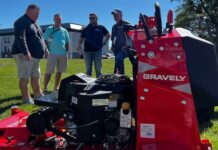Ergonomics is a word used to describe equipment design that maximizes productivity by reducing operator fatigue and discomfort. It’s a huge consideration in today’s production-intense commercial mowing market because of: operator safety; operator production; and quality of service.

The Ferris Evolution series of mowers features the company’s patented suspension system.
PHOTO COURTESY OF FERRIS.
Ergonomics go way beyond cup holders and extra storage compartments for jackets. It includes, among other factors, ease of starting, effort needed to mount and dismount, ease of use, seat and back comfort, better noise dampening, stability, and controls that are handy to operate. This is asking a lot of manufacturers, more specifically their industrial engineers, given that machines are used by both large and small operators, operators with different levels of experience, and the widely varying types and sizes of properties that commercial cutters must maintain.
If you as an owner/operator or your employees aren’t comfortable, or you find a particular model unhandy to operate, operator fatigue becomes an issue. Fatigue leads to inattention, poor service, and, in worst cases, to accident or injury. Obviously, those who spend a day being beat up or wrestling with a difficult-to-operate machine won’t be productive and likely won’t do a good job.
Manufacturers are addressing these issues with seat cushioning, better suspension systems, noise dampening, and by designing and placing controls that are more user-friendly.
It’s been more than 10 years since Ferris introduced its patented suspension systems. It remains very popular with operators and is now also featured on the company’s new Evolution line of mowers. “We invented and patented suspension technology, and now we’ve integrated that technology into the Ferris Evolution,” says Bill Shea, vice president, sales & marketing, commercial products for the Briggs & Stratton Yard Power Products Group and the Ferris brand.
Adds Grasshopper’s Trent Guyer: “Good ergonomic design not only improves operator experience, but actually leads to better performance as measured by faster job completion and improved cut quality.”

The Gravely Pro Turn 400 zero-turn mower is an example of what manufacturers are doing to improve operator comfort and ease of use in their units. “An air-ride suspension seat provides a softer ride than typical suspension seats found on other mowers,” says Brian Anundsen, product marketing manager, commercial & turf. “Gravely also isolated the seat and the foot platform from the frame, providing an even greater level of comfort. Consumers are expecting quality and reliability, and are turning their focus to comfort and user-friendly features.”
Meanwhile, manufacturers of out-front (front-mount) mowers—companies such as Walker, Grasshopper and Lastac, among others—claim that the design of their units gives operators a better view of what they’re cutting.

Cub Cadet touts the stability of its steering-wheel versions of its Tank units, which also come with stick controls.
PHOTO COURTESY CUB CADET.
In other words, manufacturers are attempting to make the operator/machine interaction as seamless as possible. This isn’t an easy task, since operators come in all sizes and shapes and mow in many different environments.
Ultimately, the operators of the mowers themselves will let you know which brands and models they prefer. They will avoid, if they can, using machines that beat them up or make production difficult. Smart contractors take every opportunity they can to demo units or bring them to their site to let their employees put them through their paces before they buy or lease them.











![[VIDEO] Dickies®: Discover Workwear That’s Anything But Uniform](https://turfmagazine.com/wp-content/uploads/2023/06/1647663814-4b1a2a7742790a9b1e97a3b963477850192e1d6a9dfba9b07214a77bae25d6e3-d-218x150.jpg)




























![[VIDEO] Dickies®: Discover Workwear That’s Anything But Uniform](https://turfmagazine.com/wp-content/uploads/2023/06/1647663814-4b1a2a7742790a9b1e97a3b963477850192e1d6a9dfba9b07214a77bae25d6e3-d-324x160.jpg)